Content for TS 38.413 Word version: 18.2.0
1…
4…
8…
8.2…
8.2.3…
8.3…
8.3.4…
8.4…
8.4.3…
8.5…
8.7…
8.8…
8.10…
8.12…
8.17…
9…
9.2…
9.2.2…
9.2.3…
9.2.4…
9.2.6…
9.2.7…
9.2.9…
9.2.11…
9.2.16…
9.2.17…
9.3…
9.3.1.21…
9.3.1.41…
9.3.1.61…
9.3.1.81…
9.3.1.101…
9.3.1.121…
9.3.1.141…
9.3.1.161…
9.3.1.181…
9.3.1.205…
9.3.1.222…
9.3.1.245…
9.3.2…
9.3.3…
9.3.3.21…
9.3.3.42…
9.3.4…
9.3.4.10…
9.3.5…
9.4…
9.4.4
9.4.5
9.4.6…
9.5…
10…
8.10 NRPPa Transport Procedures
8.11 Trace Procedures
8.11.1 Trace Start
8.11.2 Trace Failure Indication
8.11.3 Deactivate Trace
8.11.4 Cell Traffic Trace
...
...
8.10 NRPPa Transport Procedures p. 112
8.10.1 General p. 112
The purpose of the NRPPa Transport procedures is to carry NRPPa signalling (defined in TS 38.455) between the NG-RAN node and the LMF over the NG interface.
The Downlink UE Associated NRPPa Transport procedure and the Uplink UE Associated NRPPa Transport procedure use UE-associated signalling. The UE-associated signalling is used to support E-CID Location Information Transfer, Positioning Information Transfer, Measurement Preconfiguration Information Transfer, and Reporting of General Error Situations due to reception of an NRPPa message that utilized UE-associated signalling.
The Downlink Non UE Associated NRPPa Transport procedure and the Uplink Non UE Associated NRPPa Transport procedure use non-UE associated signalling. The non-UE associated signalling is used to support OTDOA Information Transfer, Assistance Information Transfer, TRP Information Transfer, Measurement Information Transfer, PRS Information Transfer, Area-specific Information Transfer and Reporting of General Error Situations due to reception of an NRPPa message that utilized non-UE associated signalling.
8.10.2 Successful Operations p. 112
8.10.2.1 DOWNLINK UE ASSOCIATED NRPPA TRANSPORT p. 112
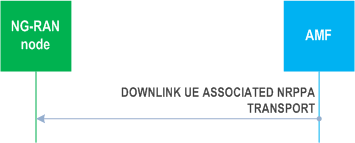
The AMF initiates the procedure by sending the DOWNLINK UE ASSOCIATED NRPPA TRANSPORT message to the NG-RAN node.
8.10.2.2 UPLINK UE ASSOCIATED NRPPA TRANSPORT p. 113
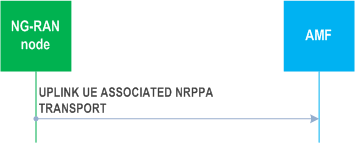
The NG-RAN node initiates the procedure by sending the UPLINK UE ASSOCIATED NRPPA TRANSPORT message to the AMF.
8.10.2.3 DOWNLINK NON UE ASSOCIATED NRPPA TRANSPORT p. 113
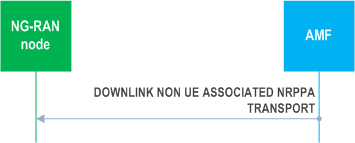
The AMF initiates the procedure by sending the DOWNLINK NON UE ASSOCIATED NRPPA TRANSPORT message to the NG-RAN node.
8.10.2.4 UPLINK NON UE ASSOCIATED NRPPA TRANSPORT p. 113
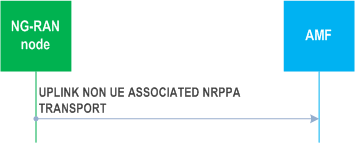
The NG-RAN node initiates the procedure by sending the UPLINK NON UE ASSOCIATED NRPPA TRANSPORT message to the AMF.
8.10.3 Unsuccessful Operations p. 113
Not applicable.
8.10.4 Abnormal Conditions p. 114
If an AMF receives an UPLINK UE ASSOCIATED NRPPA TRANSPORT message with an unknown Routing ID for the UE, the AMF shall ignore the message.
If an AMF receives an UPLINK NON UE ASSOCIATED NRPPA TRANSPORT message indicating an unknown or unreachable Routing ID, the AMF shall ignore the message.
8.11 Trace Procedures p. 114
8.11.1 Trace Start p. 114
8.11.1.1 General p. 114
The purpose of the Trace Start procedure is to allow the AMF to request the NG-RAN node to initiate a trace session for a UE. The procedure uses UE-associated signalling. If no UE-associated logical NG-connection exists, the UE-associated logical NG-connection shall be established as part of the procedure.
8.11.1.2 Successful Operation p. 114
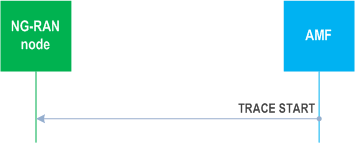
The AMF initiates the procedure by sending a TRACE START message. Upon reception of the TRACE START message, the NG-RAN node shall initiate the requested trace session as described in TS 32.422.
If the Trace Activation IE is included in the TRACE START message which includes the MDT Activation IE set to "Immediate MDT and Trace", the NG-RAN node shall, if supported, initiate the requested trace session and MDT session as described in TS 32.422.
If the Trace Activation IE is included in the TRACE START message which includes the MDT Activation IE set to "Immediate MDT Only", "Logged MDT only", the NG-RAN node shall, if supported, initiate the requested MDT session as described in TS 32.422 and the NG-RAN node shall ignore the Interfaces To Trace IE and the Trace Depth IE.
If the Trace Activation IE includes the MDT Location Information IE within the MDT Configuration IE, the NG-RAN node shall, if supported, store this information and take it into account in the requested MDT session.
If the Trace Activation IE is included in the TRACE START message which includes the MDT Activation IE set to "Immediate MDT Only", "Logged MDT only" and if the Signalling Based MDT PLMN List IE is included in the MDT Configuration IE, the NG-RAN node may use it to propagate the MDT Configuration as described in TS 37.320.
If the Trace Activation IE includes the Bluetooth Measurement Configuration IE within the MDT Configuration IE, the NG-RAN node shall, if supported, take it into account for MDT Configuration as described in TS 37.320.
If the Trace Activation IE includes the WLAN Measurement Configuration IE within the MDT Configuration IE, the NG-RAN node shall, if supported, take it into account for MDT Configuration as described in TS 37.320.
If the Trace Activation IE includes the Sensor Measurement Configuration IE within the MDT Configuration IE, the NG-RAN node shall, if supported, take it into account for MDT Configuration as described in TS 37.320.
If the Trace Activation IE includes the MDT Configuration IE and if the NG-RAN node is a gNB at least the MDT Configuration-NR IE shall be present, while if the NG-RAN node is an ng-eNB at least the MDT Configuration-EUTRA IE shall be present.
If the PNI-NPN Area Scope of MDT IE is included in the MDT Configuration-NR IE included in the TRACE START message, the NG-RAN node shall, if supported, use it to derive the MDT area scope for MDT measurement collection in PNI-NPN areas. Upon reception of the PNI-NPN Area Scope of MDT IE, the NG-RAN node shall consider that the area scope for MDT measurement collection in PNI-NPN areas is defined only by the areas included in the PNI-NPN Area Scope of MDT IE.
If the Trace Activation IE includes the MN Only MDT Collection IE and the MN Only MDT Collection IE is set to "MN only", the NG-RAN node shall, if supported, consider that the MDT Configuration-NR IE or the MDT Configuration-EUTRA IE is only applicable for the MN if the UE is configured with MR-DC.
Interactions with other procedures:
If the NG-RAN node is not able to initiate the trace session due to ongoing handover of the UE to another NG-RAN node, the NG-RAN node shall initiate a Trace Failure Indication procedure with the appropriate cause value.
8.11.1.3 Abnormal Conditions p. 115
If the PNI-NPN Area Scope of MDT IE is included in the MDT Configuration-NR IE in the TRACE START message, and the Area Scope of MDT IE is set to "PNI-NPN Based MDT", the NG-RAN node shall, if supported, use the Area Scope of MDT IE to derive the MDT area scope for MDT measurement collection in PNI-NPN areas, and ignore the PNI-NPN Area Scope of MDT IE.
8.11.2 Trace Failure Indication p. 115
8.11.2.1 General p. 115
The purpose of the Trace Failure Indication procedure is to allow the NG-RAN node to inform the AMF that a Trace Start procedure or a Deactivate Trace procedure or an ongoing trace has failed due to an interaction with a handover procedure or, while the UE is in RRC_INACTIVE state, due to reception of multiple trace activations. The procedure uses UE-associated signalling.
8.11.2.2 Successful Operation p. 115
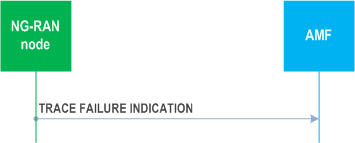
The NG-RAN node initiates the procedure by sending a TRACE FAILURE INDICATION message. Upon reception of the TRACE FAILURE INDICATION message, the AMF shall take appropriate actions based on the failure reason indicated by the Cause IE.
8.11.2.3 Abnormal Conditions p. 115
Void.
8.11.3 Deactivate Trace p. 116
8.11.3.1 General p. 116
The purpose of the Deactivate Trace procedure is to allow the AMF to request the NG-RAN node to stop the trace session for the indicated trace reference. The procedure uses UE-associated signalling.
8.11.3.2 Successful Operation p. 116
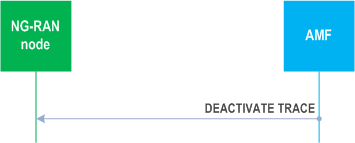
The AMF initiates the procedure by sending a DEACTIVATE TRACE message to the NG-RAN node as described in TS 32.422. Upon reception of the DEACTIVATE TRACE message, the NG-RAN node shall stop the trace session for the indicated trace reference in the NG-RAN Trace ID IE.
Interactions with other procedures:
If the NG-RAN node is not able to stop the trace session due to ongoing handover of the UE to another NG-RAN node, the NG-RAN node shall initiate a Trace Failure Indication procedure with the appropriate cause value.
8.11.3.3 Abnormal Conditions p. 116
Void.
8.11.4 Cell Traffic Trace p. 116
8.11.4.1 General p. 116
The purpose of the Cell Traffic Trace procedure is to send the allocated Trace Recording Session Reference and the Trace Reference to the AMF. The procedure uses UE-associated signalling.
8.11.4.2 Successful Operation p. 116
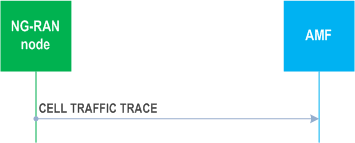
The NG-RAN node initiates the procedure by sending a CELL TRAFFIC TRACE message.
If the Privacy Indicator IE is included in the message, the AMF shall take the information into account for anonymization of MDT data as described in TS 32.422.
8.11.4.3 Abnormal Conditions p. 117
Void.